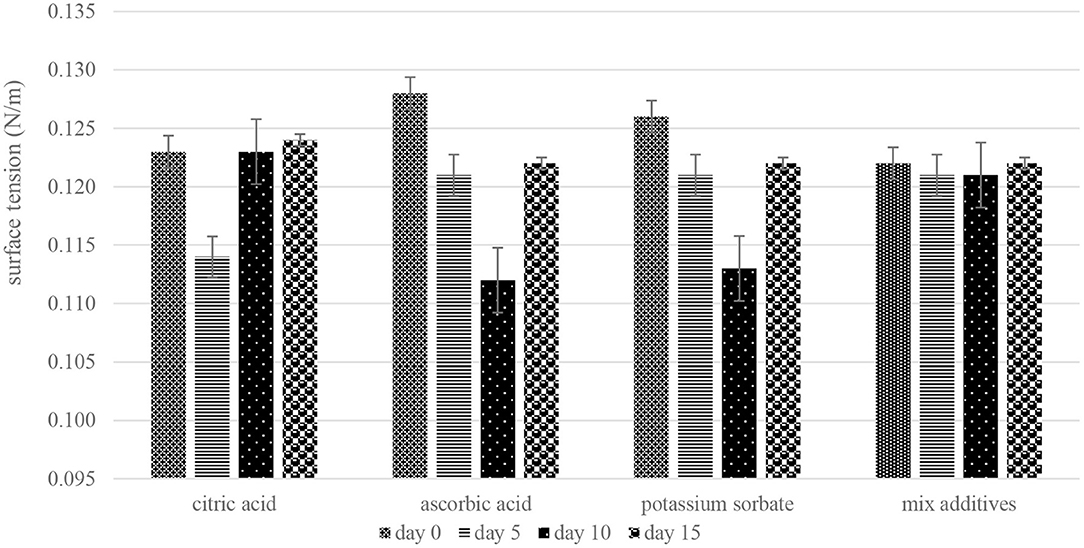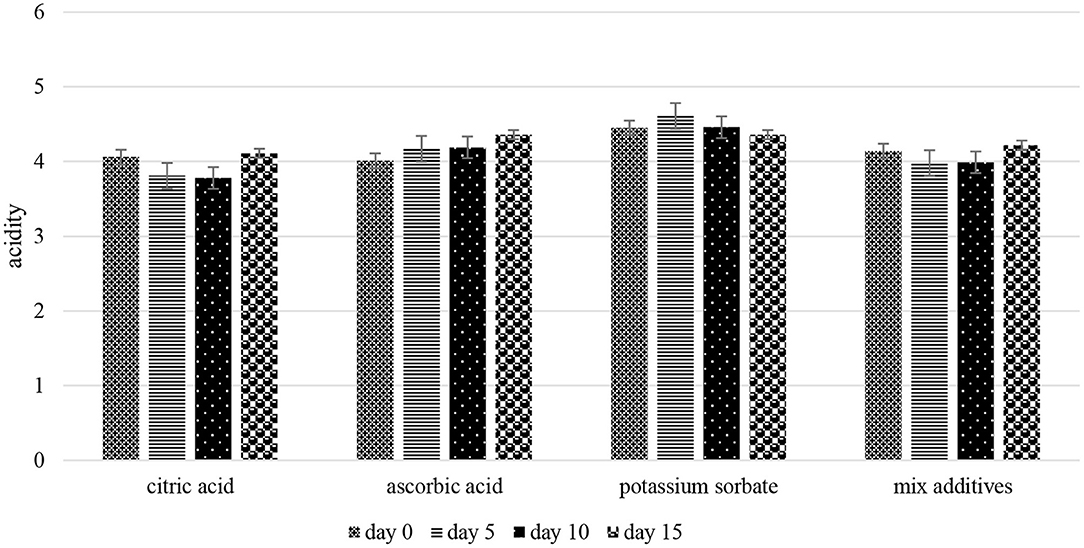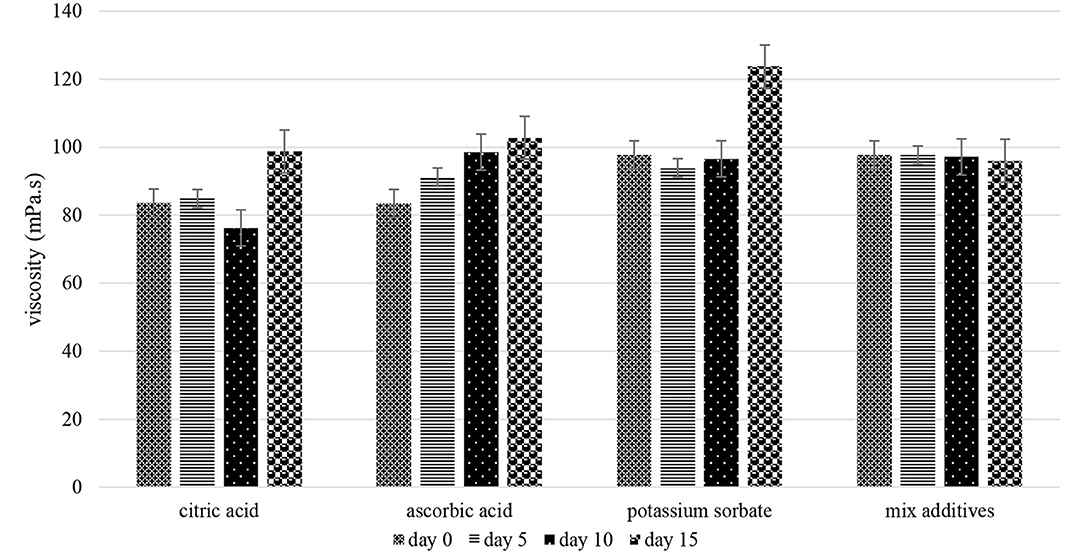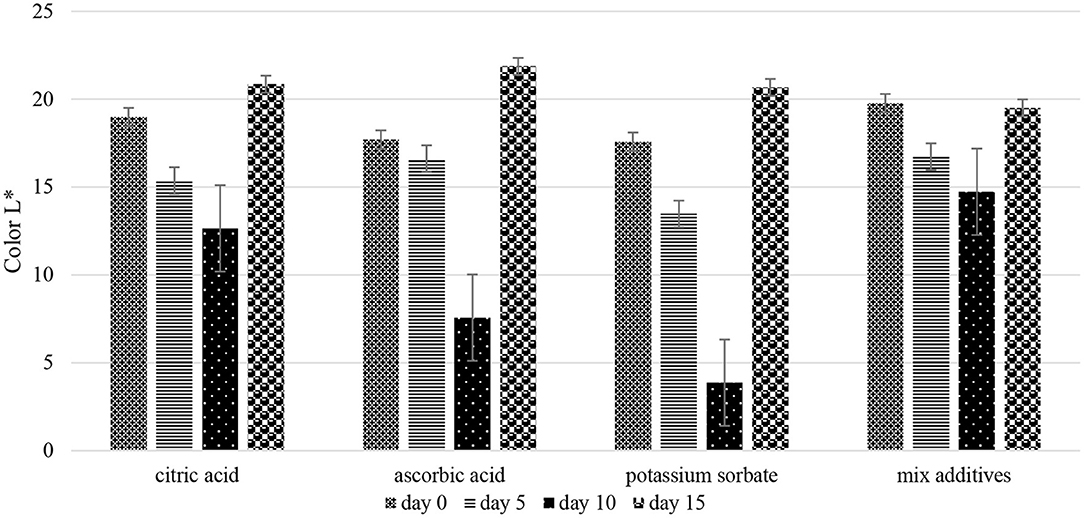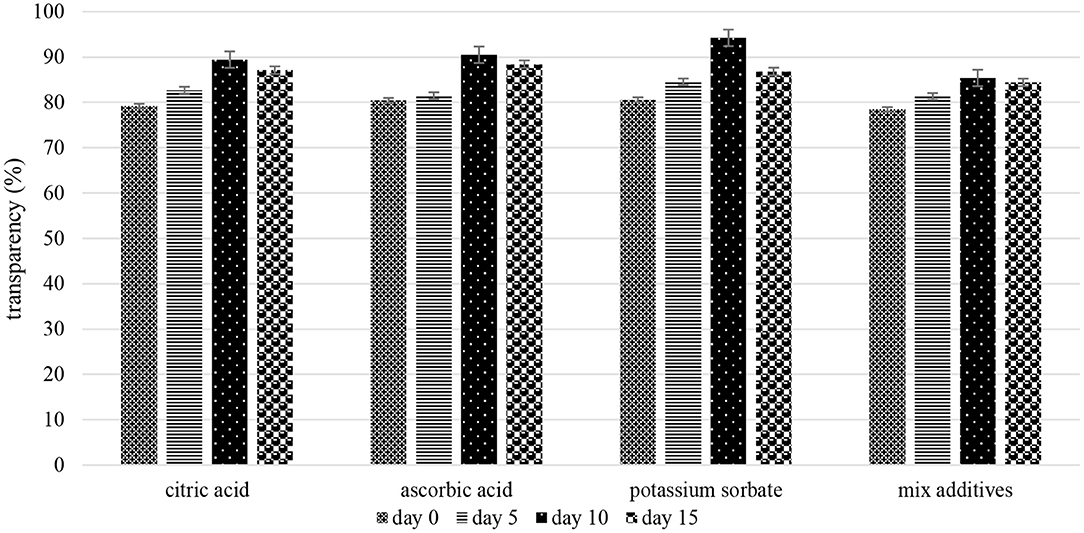- 1Food Science and Technology Department, Agriculture Faculty, Warmadewa University, Denpasar, Indonesia
- 2Department of Agricultural Engineering, Agriculture Technology Faculty, Udayana University, Denpasar, Indonesia
- 3Agriculture Technology Faculty, Technology of Agriculture Industry, Udayana University, Denpasar, Indonesia
Coating is a new trend for extending shelf-life and reducing postharvest damage to fruits currently. Aloe vera gel-based (AVG) coating is made by adding citric acid, ascorbic acid and potassium sorbate. The additive increases the stability of AVG coating. This research aims to determine the effect of additives on the surface tension, viscosity, transparency and morphology structure of AVG coating. The observation used a completely random design one factor with three replicates. Formulation of AVG coating uses additives involving citric acid, ascorbic acid, potassium sorbate and the mixture of additives, concentrations of 0.15%. Observations are made periodically on days 0, 5, 10 and 15. The type and concentration of additives affect the surface tension, viscosity, transparency and morphology structure of AVG coating. The best formulation of AVG coating for 15 days of storage is a mixture of additives (citric acid, ascorbic acid and potassium sorbate) with a concentration of 0.15% applied on the surface of the fruits. The best numeric value of AVG coating surface tension is 0.122 N/m, acidity 4.22, viscosity 96.03 mPa.s, color L* 19.51 and point of transparency 84.40. The combination of the three additives produced a clear, transparent white coating appearance and the potential to extend the shelf-life of fruit.
Introduction
Fruits are commodities that are growing rapidly at this time, stimulated by the need for food that can improve health. The drawbacks are very short shelf life and perishability, requiring proper postharvest handling to reach customers fresh. One alternative method that can be used to increase the shelf life of fruits in recent years is a coating (Abu-Shama et al., 2020). The coating is a thin layer of food packaging, environmentally friendly and biodegradable (Suhag et al., 2020). Ideal size of coating is 20–110 nm (Zambrano-Zaragoza et al., 2018). The coating can also function as a carrier for additives; a barrier to chemical, physical and biological changes; a barrier to gas exchange of O2 and CO2, water vapor and mass transfer (Suriati et al., 2020a). The parameters surface tension, viscosity, transparency and morphology structure are chosen in the study because according to Galgano et al. (2015) and Kumar et al. (2021a) can cover the coated surface (adhesion) which is closely related to surface tension and morphology structure of the coating. In addition, the coating is easily emulsified, has low viscosity, is non-sticky, dries quickly, is bright and transparent. The coating application on fruits or vegetables improves a bright, shiny appearance, retains moisture, prevents weight loss and acts as an antimicrobial (Shah and Hashmi, 2020). According to Basaglia et al. (2021), the coating helps maintain the quality and extends the shelf life of fruits and vegetables. The added advantages of using coating are as follows: It does not pollute the environment; it is a preservative-free food product and can maintain taste and color retention (Awad et al., 2021).
The ingredients of coatings consist of lipids, polysaccharides, proteins and composites (Kumar et al., 2021b; La et al., 2021). Polysaccharide-based coating provides an excellent barrier to oxygen due to its dense hydrogen bond network structure (Singh et al., 2020). The addition of antioxidant additives such as citric acid and ascorbic acid to coating results in better-quality maintenance (Ali et al., 2020; Karimah et al., 2021). The microbiological spoilage of coated fruits suggests the importance of adding antimicrobials to coating (Karimah et al., 2021; Kumar et al., 2021c). Potassium sorbate has been reported to have the potential as an antimicrobial that can be incorporated in coatings. The type and concentration of additives determine the consistency and stability of the coating, currently, the information is very limited. Stability determines the adhesion of coating to the surface of the product. One of the natural ingredients with the potential as a constituent of coatings is Aloe vera gel (AVG) (Suriati et al., 2020b; Manzoor et al., 2021).
AVG consists of polysaccharides containing more than 75 functional chemical compounds, has antioxidant and antimicrobial properties, and can retain moisture such that it can inhibit postharvest damage, increase shelf life and maintain the quality of fruits (Suriati and Utama, 2019; Nia et al., 2021). AVG has a very high enzyme activity, is easily oxidized, changes color and has a bad performance (Sánchez et al., 2020). Its viscosity drastically decreases to close to that of water when stored at room temperature for 24–36 h (Suriati et al., 2020b). The physicochemical properties of AVG are also greatly influenced by air, light and heat (Liu et al., 2021; Suriati et al., 2021). The advantages of using AVG coating are its biodegradability, permeability to oxygen, antioxidant power, low toxicity effect, and low-cost, easy application as well as an alternative to the use of chemicals after harvest (Hasan et al., 2021; Suriati et al., 2021).
The ability of AVG coatings as a matrix or additive carrier is influenced by structure, molecular size and chemical content (Jafarzadeh et al., 2021; La et al., 2021; Suriati and Suardani, 2021). The advantages of using additives on AVG coating include antimicrobial ability, emulsion system stability, barrier properties and bioavailability (Singh et al., 2020). Additives on coating also expand the surface such that it can improve stability such as solubility, absorption of active compounds and controlled release. However, to the best of the author's knowledge, information on the use of additives on coating, especially the type and concentration does not yet exist. Therefore, the exact type of additives and storage time on AVG coating need to be studied to obtain a good coating formula with the potential to extend the shelf-life of fruit. Coating formulas made from AVG can be used immediately after preparation. The storage for up to 15 days to see the characteristic changes of the coating survive cold temperature storage. This paper aims to determine the effect type of additives and storage time on the surface tension, viscosity, transparency and morphology structure of AVG coating.
Materials and Methods
The material used in this paper is the leaf part of the Aloe vera (Aloe barbadense. Mill), which was taken as the gel raw material for coating, obtained from the Taro village, Tegalalang District, Gianyar Regency Bali Province Indonesia. Coating formulation with additives uses a completely randomized design with one factor. The type of additive, namely, citric acid, ascorbic acid and potassium sorbate as well as a mixture of the three additives each of concentration was varied of 0.15% (w/v) or equivalent to 1.5 grams per 1 liter of AVG. Observations are made periodically on days 0, 5, 10 and 15. Control was prepared as a comparison utilizing AVG without adding additives and repeated three times.
Preparation of the AVG
The AVG was prepared by first sorting the leaves harvested after 1 year of age. The selected leaves were intact, straight and without blemishes or rot. The position of the leaves was taken as the lowest three midribs of the Aloe vera plant with a length of about 40–50 cm. The leaves were left for 24 h at room temperature to remove the yellow mucus. Then, they were washed thoroughly with chlorinated water to remove the impurities and dust particles that can reduce the quality of the gel. Stripping and fileting using a stainless-steel knife followed. The next treatment was homogenization using Philip HR 2116 Japan at a speed of 2–5 min to produce aloe gel. Heating at a temperature of (70 ± 1)°C for 5 min to inactivate the enzyme followed. The gel was cooled for 1 h to a temperature of 27°C, then filtered with a Rocker 300 vacuum pump, 5340FK1000R flash filter and Whatman filter paper number 42. The gel was then added with each type of additive, namely, citric acid, ascorbic acid, potassium sorbate and the three mixtures with concentrations of 0.15% (w/v). The agitation used a sonicate model Q125 Masonic to obtain the additive structures, with a pulse 59-time delay of 30 s for 50 min. AVG should be stored in a dark-colored glass container to avoid the influence of light on sensitive bioactive agents. Furthermore, it was stored at a cold temperature (7 ± 1)°C and the observations were carried out on days 0, 5, 10 and 15.
Determination of the Properties of AVG
The observation variables of AVG included the surface tension, acidity, viscosity, color (L*) and transparency. Surface tension was measured using the Vargas et al. (2008) methods. Acidity was tested using a digital pH meter (Hanna HI 8424, Romania). Viscosity was measured with a NDJ8S viscometer, the chromatic attribute of coating of AVG was tested using a spectral colorimeter CS-280 to determine the coordinates of L * a * b *. Coating transparency was measured using the Al-Hasan and Norziah (2012) method. Transparency values are produced from the following equation: Transparency = (ΔL2 + Δa2 +Δb2)0.5. Value of ΔL = L* standard – L* sample, Δa = a* standard – a* sample and Δb = b* standard – b* sample. The default value for white plate is L* = 97.51, a* = 5.35 and b* = −3.37.
Preparation of an AVG Coating
Preparing an AVG coating for SEM analysis, AVG is poured in Petri dish that has been dilated with aluminum foil as much as 10 ml, then drained by oven at 50°C for 3 h. Attach carbon tape to the specimen mounts to place the sample. The dry sample of AVG coating cut equal to the size of the specimen holder, then AVG coating placed on the specimen holder. Testing with SEM starts after the preparation is complete. The results are received by the detector and sent to the monitor.
Determination of the Properties of the AVG Coating
AVG coating was subsequently tested using UV-vis spectrophotometer analysis to predict the size and shape of particles. The results of UV–Vis spectroscopy show that the absorbance value can indicate qualitatively the number of particles formed. The maximum absorbance spectrum can indicate the size of the particles produced. The results of the UV–Vis spectrophotometer analysis still need to be strengthened by other analyses such as SEM. AVG coating provides an absorption peak at a wavelength of around 284 nm such that the transmittance is 0.5012%. Percent transmittance (%T) is used to measure the clarity of a solution or dispersion system quantitatively. A high percent transmittance value means that the particle size is becoming smaller. The small particle size causes the brown motion to occur faster. The faster brown motion prevents sedimentation and makes the solution clearer. Water is used as a comparison because it does not have particles that hold light transmission. Light will continue passing through it without any light scattering effect such that it has a transmittance value of 100%. Morphology and structure of AVG coating by scanning electron microscopy (SEM) type JEOL JSM-6510LA (Zambrano-Zaragoza et al., 2013).
Result and Discussion
Surface Tension of the AVG
The surface tension of a liquid is the tendency of the surface of the liquid to tighten such that the surface seems to be covered by an elastic layer. The surface tension of a liquid occurs because of the difference in the resultant attraction of the molecules on the surface of the liquid or because of adhesion and cohesion forces. Decreasing interface tension can increase the adhesion force between the surface of the fruit and the coating material (Corrales et al., 2014). The results show that increasing the concentration of additives increased the surface tension of coating on day 0. The surface tension of the coating liquid is directly proportional to the cohesion power between the constituent materials and inversely proportional to the adhesion power between the coating and the material to be coated (Corrales et al., 2014). Galante et al. (2020) stated that the addition of excessive additives can increase the surface tension of the coating fluid.
Citric acid, ascorbic acid and potassium sorbate contributed to changes in the surface tension of the coating during storage, but not the mixture of the three additives (Figure 1). The addition of additives to AVG coating for stabilization is required at low concentrations. Supported by the opinion of Zhang et al. (2021), that excessive addition of the additive can increase the surface tension of the coating liquid. Increasing the interface tension can reduce the adhesion force between the fruit surfaces and the coating material. Adhesion is a bonding phenomenon in a complex surface that is the tensile strength between two different surfaces. Thus, the treatment of the mixture additive resulted in a relatively stable AVG coating surface tension over 15 days. If perfect contact is achieved, the intermolecular interaction distance will shorten such that adhesion is achieved (Suriati et al., 2020c). Low adhesion means the coating may be difficult to adhere to or easily come off. The addition of excessive additives can increase the surface tension of the coating fluid (Maringgal et al., 2020).
Acidity of the AVG
The level of acidity is a parameter that indicates the acidity of a substance or solution. Potassium sorbate increased acidity on day 0 compared with other treatments because enzyme activity can be suppressed to form fewer organic acids (Figure 2). Day 5 of the citric acid additive treatment produced the lowest acidity because citric acid is an acidulant compound that can lower acidity. The acidity of citric acid is obtained from the three COOH carboxyl groups that can release protons in a solution (Nascimento et al., 2020). Citric acid can be used to regulate acidity or food preservatives and prevent the browning of fruits. Citric acid is an acidulant and chelating compound; it can complex copper ions that act as a catalyst, inhibit browning by lowering the acidity such that the polyphenol oxidase (PPO) enzyme becomes inactive (Escamilla-García et al., 2018). Aloe gel is known to be stable at a low acidity. The addition of additives prolongs shelf life due to enzyme inactivation, preventing the breakdown of polysaccharides into arachidonic acid, γ-linoleic acid and other organic acids (Sánchez et al., 2020).
Viscosity of the AVG
Viscosity is a measure that states the thickness of a liquid or fluid. Increasing the concentration of potassium sorbate on day 0 resulted in a higher viscosity of coating (Figure 3). It is in line with the opinion of Singh et al. (2020), that additive accumulation strengthens the cross-linking of polysaccharide polymers. Migration of additives into acetyl glucomannan bonds increases the molecular weight of AVG coating and increases the viscosity value. The enzymes in Aloe vera gel are very active and affect the viscosity of the gel (Quezada et al., 2017; Nicolau-Lapeña et al., 2021). The mix of additives caused the coating viscosity to be relatively stable for 15 days. The mixture of additives, namely, citric acid, ascorbic acid and potassium sorbate can synergize and strengthen the cohesive bonds of AVG coating polymers. Supported by the opinion of Rehman et al. (2020), the stability of the coating is maintained by the addition of additives. Research (Saberi et al., 2018) stated that increasing the concentration of the filler in the solution increases the viscosity.
Color (L*) of the AVG
Color plays an important role in the choice of food ingredients by consumers before considering nutritional value and taste. This parameter is used as a subjective indicator of product quality, although the frequently used edible coating is transparent and does not affect the display color. The synergy of the additive mixture of citric acid, ascorbic acid and 0.15% potassium sorbate on the 0th day resulted in the brightest color of coating (Figure 4). This is indicated by the smallest L* value. The addition of an additive mixture can suppress color changes and maintain brightness which leads to its stability and effectiveness as a coating. Stabilization is carried out by proper processing techniques, heating treatment and adding preservatives and other additives such as potassium sorbate, citric acid and ascorbic acid (Awad et al., 2021).
Mixture additive capable of suppressing color changes and maintaining brightness, which led to the stability and effectiveness of coating on the 5th and 10th days. AVG has the potential to be bio preservative, forming a waxy coating that can increase the shelf life of fruits (Ozturk et al., 2019). The proportion of 0.15% mixture additive is ideal for maintaining the L* value. Suriati et al. (2020d) reported that the addition of additives can maintain the stability of aloe gel. Turbidity is a manifestation of the result of polymer gel hydrolysis, which occurs after enzymatic reactions and physicochemical properties that are strongly influenced by air, light and heat. On direct contact with air, the gel color becomes pink and finally brown (Hasan et al., 2021). Citric acid is a browning inhibiting agent. This compound also lowers the acidity and inactivates the PPO enzyme (Mirshekari et al., 2019).
Transparency of the AVG
Transparency coating which when dry form a transparent film. AVG coating had the highest transparency value in the potassium sorbate because it is an unsaturated fatty acid in the form of yellowish-brown powder (Sui Chin et al., 2017). Potassium sorbate increases turbidity such that transparency. The lowest AVG coating transparency of 85.38 was obtained from the treatment of a 0.15% mixture additive on the 10th day (Figure 5). One of the special requirements for coatings according to Basaglia et al. (2021), is that it has a transparent sensory property. According to Gürbüz and Kahramanoglu (2021), the antioxidant citric acid and ascorbic acid incorporated into a methylcellulose-based edible coating resulted in a transparent coating on the apricots and extended shelf life.
The results of the 15th-day study showed an increase in the transparency value of AVG coating with various additives over a longer storage period. High transparency values are indicated by the appearance of increased turbidity because storage is assumed to facilitate the breaking of the acetyl bond of the glucomannan polymer into smaller components, which then affects the level of gel transparency. AVG is part of the clear parenchyma cells and has decreased stability during storage (Sonawane et al., 2021). Satriaji et al. (2020) reported that the additive can increase the transparency value of the coating. The ascorbic acid type and the mixture additive responded almost equally to the coating's transparency during storage. Transparency AVG coating with mixture additive was relatively stable for up to 15 days compared with others. The combination of the three additives produced a clear, transparent white AVG coating appearance.
Morphology of AVG Coating
Observation morphology of AVG coating using scanning electron microscopy (Thakur et al., 2018). The results of AVG coating morphology observations before application to the surface of fruits showed that the addition of additives resulted in different morphologies, as shown in Figure 6. The structure of AVG coating with additives from SEM (Figure 6) shows that the particle size is smaller. The small particle size results in new physicochemical properties, such as surface area, reactivity and color, which are very different from conventional-sized materials (Pérez-Esteve et al., 2013). The additive particles are between the cross-linking bonds of the AVG polymer and contribute to its stability. This morphology is different from the morphology of AVG coating without additives (Figure 6A) and AVG coating with additives (Figures 6B,C). The advantages of additives are antimicrobial ability, improved barrier properties, flexibility and durability. Additive AVG coating acts as a reinforcing agent because it reduces the matrix participation mechanism. This finding is related to the interaction between additive and the matrix; the transfer of water vapor and gas becomes increasingly difficult due to the tortuous pathway (Qureshi et al., 2020). The use of AVG coatings with applications on food surfaces aims to modify the environment, barrier mass transfer, and improve appearance (Ali et al., 2019). Molecular structure, size, and additives content determine the properties of the coating. Opinion (Gokularaman et al., 2017), states that the addition of additives improves the polymer composition of the coating matrix.
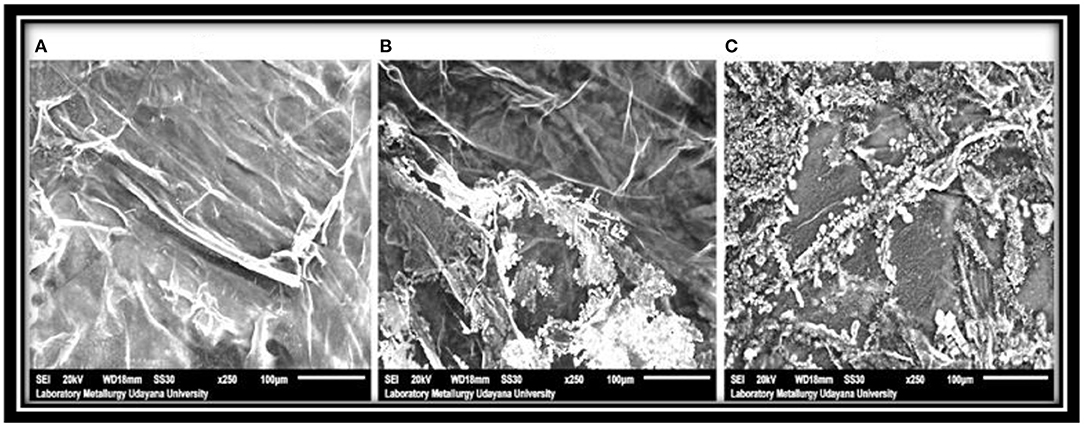
Figure 6. Morphology of AVG coating without additive (A), AVG coating with mixture of citric acid, ascorbic acid and potassium sorbate additive (B,C).
Conclusion
The conclusion of this research is the type of additives and storage time affect surface tension, viscosity, transparency and morphological structure of the AVG coating. The best AVG coating formulation for 15 days storage is a mixture of additives, namely citric acid, ascorbic acid and potassium sorbate at a concentration of 0.15%. The combination of the three additives produced a clear, transparent white AVG coating appearance.
Data Availability Statement
The raw data supporting the conclusions of this article will be made available by the authors, without undue reservation.
Author Contributions
IU: methodology. BH: manuscript detail. IG: data analysis. All authors contributed to the article and approved the submitted version.
Conflict of Interest
The authors declare that the research was conducted in the absence of any commercial or financial relationships that could be construed as a potential conflict of interest.
Publisher's Note
All claims expressed in this article are solely those of the authors and do not necessarily represent those of their affiliated organizations, or those of the publisher, the editors and the reviewers. Any product that may be evaluated in this article, or claim that may be made by its manufacturer, is not guaranteed or endorsed by the publisher.
Acknowledgments
The authors are grateful to the Rector of Warmadewa University for supporting the project and to all colleagues for assisting in this project.
References
Abu-Shama, H. S., Abou-Zaid, F. O. F., and El-Sayed, E. Z. (2020). Effect of using edible coatings on fruit quality of Barhi date cultivar. Sci. Hortic. 265, 109262. doi: 10.1016/j.scienta.2020.109262
Al-Hasan, A. A., and Norziah, M. H. (2012). Starch gelatine edible films: Water vapor permeability and mechanical properties as affected by plasticizers. Food Hydrocoll. 26, 108–117. doi: 10.1016/j.foodhyd.2011.04.015
Ali, S., Anjum, M. A., Nawaz, A., Naz, S., Hussain, S., Ejaz, S., et al. (2020). Effect of pre-storage ascorbic acid and Aloe vera gel coating application on enzymatic browning and quality of lotus root slices. J. Food Biochem. 44, 1–11. doi: 10.1111/jfbc.13136
Ali, S., Khan, A. S., Anjum, M. A., Nawaz, A., Naz, S., Ejaz, S., et al. (2019). Aloe vera gel coating delays post-cut surface browning and maintains quality of cold stored lotus (Nelumbo nucifera Gaertn.) root slices. Sci. Hortic. 256, 108612. doi: 10.1016/J.SCIENTA.2019.108612
Awad, A. H. R., Parmar, A., Ali, M. R., El-Mogy, M. M., and Abdelgawad, K. F. (2021). Extending the shelf-life of fresh-cut green bean pods by ethanol, ascorbic acid, and essential oils. Foods 10, 1103. doi: 10.3390/FOODS10051103
Basaglia, R. R., Pizato, S., Santiago, N. G., Maciel de Almeida, M. M., Pinedo, R. A., and Cortez-Vega, W. R. (2021). Effect of edible chitosan and cinnamon essential oil coatings on the shelf life of minimally processed pineapple (Smooth cayenne). Food Biosci. 41, 100966. doi: 10.1016/j.fbio.2021.100966
Corrales, M., Fernandez, A., and Han, H. J. (2014). “Antimicrobial packaging systems,” in Innovations in Food Packaging, 2nd Edn, ed J. Han (Academic Press), 133–170. doi: 10.1016/B978-0-12-394601-0.00007-2
Escamilla-García, M., Rodríguez-Hernández, M. J., Hernández-Hernández, H. M., Delgado-Sánchez, L. F., García-Almendárez, B. E., Amaro-Reyes, A., et al. (2018). Effect of an edible coating based on chitosan and oxidized starch on shelf life of Carica papaya L., and its physicochemical and antimicrobial properties. Coatings 8, 318. doi: 10.3390/COATINGS8090318
Galante, A. J., Haghanifar, S., Romanowski, E. G., Shanks, R. M. Q., and Leu, P. W. (2020). Superhemophobic and antivirofouling coating for mechanically durable and wash-stable medical textiles. ACS Appl. Mater. Interf. 12, 22120–22128. doi: 10.1021/ACSAMI.9B23058
Galgano, F., Condelli, N., Favati, F., Di Bianco, V., Perretti, G., and Caruso, M. C. (2015). Biodegradable packaging and EDIBLE COATING for fresh-cut fruits and vegetables. Italian J. Food Sci. 27, 1–20. doi: 10.14674/1120-1770/ijfs.v70
Gokularaman, S., Stalin Cruz, A., Pragalyaashree, M. M., and Nishadh, A. (2017). Nanotechnology approach in food packaging—review. J. Pharm. Sci. Res. 9, 1743–1749. Available online at: https://www.jpsr.pharmainfo.in/issue.php?page=98
Gürbüz, R., and Kahramanoglu, I. (2021). Possibility of using leaf extracts of tree-of-heaven (Ailanthus altissima (Mill.) Swingle) for the postharvest quality preservation of fresh apricot fruits. Physiol. Mol. Plant Pathol. 113, 101594. doi: 10.1016/j.pmpp.2020.101594
Hasan, M. U., Riaz, R., Malik, A. U., Khan, A. S., Anwar, R., Rehman, R. N. U., et al. (2021). Potential of Aloe vera gel coating for storage life extension and quality conservation of fruits and vegetables: an overview. J. Food Biochem. 45, 13640. doi: 10.1111/JFBC.13640
Jafarzadeh, S., Mohammadi Nafchi, A., Salehabadi, A., Oladzad-abbasabadi, N., and Jafari, S. M. (2021). Application of bio-nanocomposite films and edible coatings for extending the shelf life of fresh fruits and vegetables. Adv. Colloid Interface Sci. 291, 102405. doi: 10.1016/j.cis.2021.102405
Karimah, A., Ridho, M. R., Munawar, S. S., Adi, D. S., Ismadi D.amayanti, R., Subiyanto, B., et al. (2021). A review on natural fibers for development of eco-friendly bio-composite: characteristics, and utilizations. J. Mater. Res. Technol. 13, 2442–2458. doi: 10.1016/j.jmrt.2021.06.014
Kumar, N., Neeraj Pratibha, and Trajkovska Petkoska, A. (2021a). Improved shelf life and quality of tomato (Solanum lycopersicum L.) by using chitosan-pullulan composite edible coating enriched with pomegranate peel extract. ACS Food Sci. Technol. 1, 500–510. doi: 10.1021/acsfoodscitech.0c00076
Kumar, N., Pratibha Neeraj, Ojha, A., Upadhyay, A., Singh, R., and Kumar, S. (2021b). Effect of active chitosan-pullulan composite edible coating enrich with pomegranate peel extract on the storage quality of green bell pepper. LWT 138, 110435. doi: 10.1016/J.LWT.2020.110435
Kumar, N., Trajkovska Petkoska, A., Khojah, E., Sami, R., and Al-Mushhin, A. A. (2021c). Chitosan edible films enhanced with pomegranate peel extract. Materials. 14, 1–18. doi: 10.3390/ma14123305
La, D. D., Nguyen-Tri, P., Le, K. H., Nguyen, P. T. M., Nguyen, M. T. H. D. B., Vo, A. T. K., et al. (2021). Effects of antibacterial ZnO nanoparticles on the performance of a chitosan/gum arabic edible coating for post-harvest banana preservation. Prog. Organ. Coat. 151, 106057. doi: 10.1016/J.PORGCOAT.2020.106057
Liu, H., Liu, S., Du, B., Dong, K., Wang, Y., and Zhang, Y. (2021). Aloe vera gel coating aggravates superficial scald incidence in ‘Starking' apples during low-temperature storage. Food Chem. 339, 128151. doi: 10.1016/j.foodchem.2020.128151
Manzoor, S., Gull, A., Wani, S. M., Ganaie, T. A., Masoodi, F. A., Bashir, K., et al. (2021). Improving the shelf life of fresh cut kiwi using nanoemulsion coatings with antioxidant and antimicrobial agents. Food Biosci. 41, 101015. doi: 10.1016/J.FBIO.2021.101015
Maringgal, B., Hashim, N., Mohamed Amin Tawakkal, I. S., and Muda Mohamed, M. T. (2020). Recent advance in edible coating and its effect on fresh/fresh-cut fruits quality. Trends Food Sci. Technol. 96, 253–267. doi: 10.1016/J.TIFS.2019.12.024
Mirshekari, A., Madani, B., and Golding, J. B. (2019). Aloe vera gel treatment delays postharvest browning of white button mushroom (Agaricus bisporus). J. Food Measure. Charact. 13, 1250–1256. doi: 10.1007/S11694-019-00040-8
Nascimento, J. I. G., Stamford, T. C. M., Melo, N. F. C. B., Nunes, I., dos, S., Lima, M. A. B., et al. (2020). Chitosan–citric acid edible coating to control Colletotrichum gloeosporioides and maintain quality parameters of fresh-cut guava. Int. J. Biol. Macromol. 163, 1127–1135. doi: 10.1016/j.ijbiomac.2020.07.067
Nia, A., Taghipour, S., and Siahmansour, S. (2021). Pre-harvest application of chitosan and postharvest Aloe vera gel coating enhances quality of table grape (Vitis vinifera L. cv. ‘Yaghouti') during postharvest period. Food Chem. 347, 129012. doi: 10.1016/j.foodchem.2021.129012
Nicolau-Lapeña, I., Aguiló-Aguayo, I., Kramer, B., Abadias, M., Viñas, I., and Muranyi, P. (2021). Combination of ferulic acid with Aloe vera gel or alginate coatings for shelf-life prolongation of fresh-cut apples. Food Packag. Shelf Life 27, 100620. doi: 10.1016/J.FPSL.2020.100620
Ozturk, B., Karakaya, O., Yildiz, K., and Saracoglu, O. (2019). Effects of Aloe vera gel and MAP on bioactive compounds and quality attributes of cherry laurel fruit during cold storage. Sci. Hortic. 249, 31–37. doi: 10.1016/J.SCIENTA.2019.01.030
Pérez-Esteve, E., Bernardos, A., Martínez-Máñez, R., and Barat, J. M. (2013). Nanotechnology in The Development of novel functional foods or their package. An overview based in patent analysis. Recent Pat. Food Nutr. Agri. 5, 35–43. doi: 10.2174/2212798411305010006
Quezada, M. P., Salinas, C., Gotteland, M., and Cardemil, L. (2017). Acemannan and fructans from Aloe vera (Aloe barbadensis Miller) plants as novel prebiotics. J. Agric. Food Chem. 65, 10029–10039. doi: 10.1021/acs.jafc.7b04100
Qureshi, M. A., Nishat, N., Jadoun, S., and Ansari, M. Z. (2020). Polysaccharide based superabsorbent hydrogels and their methods of synthesis: a review. Carbohydr.Polym. Technol. Appl. 1, 100014. doi: 10.1016/j.carpta.2020.100014
Rehman, M. A., Asi, M. R., Hameed, A., and Bourquin, L. D. (2020). Effect of postharvest application of Aloe vera gel on shelf life, activities of anti-oxidative enzymes, and quality of “gola” guava fruit. Foods 9, 1–16. doi: 10.3390/foods9101361
Saberi, B., Golding, J. B., Marques, J. R., Pristijono, P., Chockchaisawasdee, S., Scarlett, C. J., et al. (2018). Application of biocomposite edible coatings based on pea starch and guar gum on quality, storability and shelf life of ‘Valencia' oranges. Postharvest Biol. Technol. 137, 9–20. doi: 10.1016/j.postharvbio.2017.11.003
Sánchez, M., González-Burgos, E., Iglesias, I., and Gómez-Serranillos, M. P. (2020). Pharmacological update properties of Aloe vera and its major active constituents. Molecules 25, 1324. doi: 10.3390/MOLECULES25061324
Satriaji, K. P., Garcia, C. V., Kim, G. H., Shin, G. H., and Kim, J. T. (2020). Antibacterial bionanocomposite films based on CaSO4-crosslinked alginate and zinc oxide nanoparticles. Food Pack. Shelf Life 24, 100510. doi: 10.1016/j.fpsl.2020.100510
Shah, S., and Hashmi, M. S. (2020). Chitosan–Aloe vera gel coating delays postharvest decay of mango fruit. Hortic. Environ. Biotechnol. 61, 279–289. doi: 10.1007/s13580-019-00224-7
Singh, M., Singh, V., and Kaur, D. (2020). Research trends in food technology and nutrition. Res. Trends Food Technol. Nutr. 6, 73–98. doi: 10.22271/ed.book.700
Sonawane, S. K., Gokhale, J. S., Mulla, M. Z., Kandu, V. R., and Patil, S. (2021). A comprehensive overview of functional and rheological properties of Aloe vera and its application in foods. J. Food Sci. Technol. 58, 1217–1226. doi: 10.1007/S13197-020-04661-6
Suhag, R., Kumar, N., Petkoska, A. T., and Upadhyay, A. (2020). Film formation and deposition methods of edible coating on food products: a review. Food Res. Int. 136, 109582. doi: 10.1016/j.foodres.2020.109582
Sui Chin, S., Han Lyn, F., and Nur Hanani, Z. A. (2017). Effect of Aloe vera (Aloe barbadensis Miller) gel on the physical and functional properties of fish gelatin films as active packaging. Food Pack. Shelf Life 12, 128–134. doi: 10.1016/j.fpsl.2017.04.008
Suriati, L., and Suardani, N. M. A. (2021). Application Ecogel Incorporation additive for maintain freshness of Strawberry fruit during storage. IOP Conf. Ser. Mater. Sci. Eng. 1098, 062055. doi: 10.1088/1757-899x/1098/6/062055
Suriati, L., and Utama, I. M. S. (2019). Characteristic fillet of aloe vera gel as edible coating. J. Phys. Conf. Ser. 1402, 066021. doi: 10.1088/1742-6596/1402/6/066021
Suriati, L., Utama, I. M. S., Harjosuwono, B. A., and Gunam, I. B. W. (2020a). Stability aloe vera gel as edible coating. IOP Conf. Ser.: Earth Environ. Sci. 411. doi: 10.1088/1755-1315/411/1/012053
Suriati, L., Utama, I. M. S., Harsojuwono, B. A., and Gunam, I. B. W. (2020b). Incorporating additives for stability of aloe gel potentially as an edible coating. AIMS Agri. Food. 5, 327–336. doi: 10.3934/agrfood.2020.3.327
Suriati, L., Utama, I. M. S., Harsojuwono, B. A., and Gunam, I. B. W. (2020c). Physicochemical characteristics of fresh-cut tropical fruit during storage. Int. J. Adv. Sci. Eng. Inf. Technol. 10, 1731–1736. doi: 10.18517/ijaseit.10.4.10857
Suriati, L., Utama, I. M. S., Harsojuwono, B. A., and Gunam, I. B. W. (2020d). Ecogel incorporated with nano-additives to increase shelf-life of fresh-cut mango. J. Appl. Hortic. 22, 189–195. doi: 10.37855/jah.2020.v22i03.34
Suriati, L., Utama, I. M. S., Harsojuwono, B. A., Gunam, I. B. W., Adnyana, I. M., and Fudholi, A. (2021). Nano-ecogel to maintain the physicochemical characteristics of fresh-cut mangosteen. AIMS Agric. Food 6, 988–999. doi: 10.3934/agrfood.2021059
Thakur, R., Pristijono, P., Golding, J. B., Stathopoulos, C. E., Scarlett, C. J., Bowyer, M., et al. (2018). Development and application of rice starch based edible coating to improve the postharvest storage potential and quality of plum fruit (Prunus salicina). Sci. Hortic. 237, 59–66. doi: 10.1016/j.scienta.2018.04.005
Vargas, M., Pastor, C., Chiralt, A., McClements, D. J., and Inez, C. G. (2008). Recent advances in edible coatings for fresh and minimally processed fruits. Crit. Rev. Food Sci. Nutr. 48, 496–511. doi: 10.1080/10408390701537344
Zambrano-Zaragoza, M. L., González-Reza, R., Mendoza-Muñoz, N., Miranda-Linares, V., Bernal-Couoh, T. F., Mendoza-Elvira, S., et al. (2018). Nanosystems in edible coatings: A novel strategy for food preservation. Int. J. Mol. Sci. 19, 705. doi: 10.3390/ijms19030705
Zambrano-Zaragoza, M. L., Mercado-Silva, E., Ramirez-Zamorano, P., Cornejo-Villegas, M. A., Gutiérrez-Cortez, E., and Quintanar-Guerrero, D. (2013). Use of solid lipid nanoparticles (SLNs) in edible coatings to increase guava (Psidium guajava L.) shelf-life. Food Res. Int. 51, 946–953. doi: 10.1016/j.foodres.2013.02.012
Keywords: bio preservative, formula, edible coating, aloe gel, coating
Citation: Suriati L, Utama IMS, Harsojuwono BA and Gunam IBW (2022) Effect of Additives on Surface Tension, Viscosity, Transparency and Morphology Structure of Aloe vera Gel-Based Coating. Front. Sustain. Food Syst. 6:831671. doi: 10.3389/fsufs.2022.831671
Received: 08 December 2021; Accepted: 12 January 2022;
Published: 15 February 2022.
Edited by:
Poliana Mendes De Souza, Universidade Federal dos Vales do Jequitinhonha e Mucuri (UFVJM), BrazilReviewed by:
Nishant Kumar, National Institute of Food Technology Entrepreneurship and Management, IndiaIgor Velkavrh, V-Research GmbH, Austria
Andris Martinovs, Rezekne Academy of Technologies, Latvia
Sajid Ali, Bahauddin Zakariya University, Pakistan
Copyright © 2022 Suriati, Utama, Harsojuwono and Gunam. This is an open-access article distributed under the terms of the Creative Commons Attribution License (CC BY). The use, distribution or reproduction in other forums is permitted, provided the original author(s) and the copyright owner(s) are credited and that the original publication in this journal is cited, in accordance with accepted academic practice. No use, distribution or reproduction is permitted which does not comply with these terms.
*Correspondence: Luh Suriati, c3VyeWF0aV9sdWhAeWFob28uY29t
 Luh Suriati
Luh Suriati I. Made Supartha Utama2
I. Made Supartha Utama2